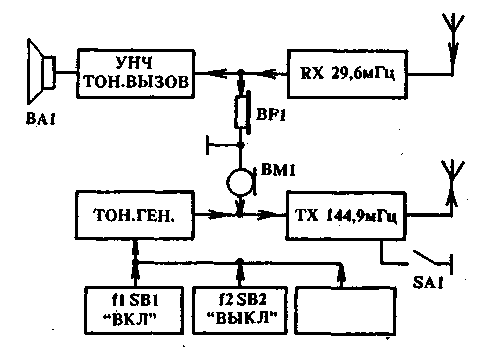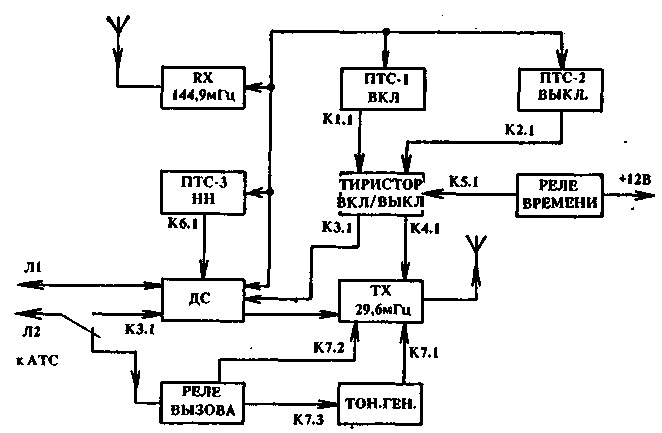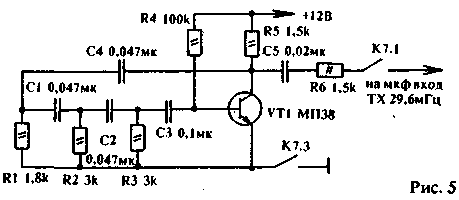
|
|
ENCYCLOPEDIA OF RADIO ELECTRONICS AND ELECTRICAL ENGINEERING Radio telephone RTF-92. Encyclopedia of radio electronics and electrical engineering
Encyclopedia of radio electronics and electrical engineering / Telephony Specially on the instructions of the editors of "RL", a simple scheme of an amateur radiotelephone "RTF-92" with access to an automatic telephone exchange was developed. With this device, you can make phone calls from the car, from the cottage, or on a camping trip, turn on the alarm system of the apartment and office, and also use the "RTF-92" as a wireless handset-phone. The principle of operation of "RTF-92" is based on conventional tone radio control. The block diagram of "RTF-92" is shown in Fig.1 and Fig.2 and includes mobile and stationary parts.
The mobile part consists of a duplex radio station, a three-frequency tone signal generator, a low-frequency amplifier for receiving a tone call, and a dialer. The fixed part consists of a duplex radio station, three receivers of tone signals (PTS1, PTS2, PTS3), a differential system, a thyristor on-off device for the differential system and a transmitter, a call relay, a call tone generator and a time relay. The schematic diagram of the mobile part is shown in Fig.3. A tone generator is assembled on transistors VT3, VT4, which is turned on by buttons SB1, SB2, SB3 or by a dialer through diodes VD1 - VD3, and the frequency of the generator is selected by resistors R8, R9, R10 to the frequency of tone signal receivers PTS1 - PTS3. An amplifier is assembled on transistors VT1, VT2, from the output of which the voltage of the tone signals is supplied through the capacitor C1 to the microphone input transmitter. An electronic key for the dialer and reset button SB5 is assembled on the VT3 transistor. Switch SA1 is designed to turn on the transmitter. The schematic diagram of the stationary part is shown in Fig.4. On transistors VT1, VT2, a common amplifier of tone signals is assembled, coming from the low-frequency output of the receiver through resistor R1 and capacitor C1 to its input. The tone signal receiver with a frequency of 1610 Hz (PTS-1) on the transistor VT3 and elements L1, C5, K1 is designed to turn on the differential system and the transmitter with contacts K1.1, K3, G, K4.1. On the transistor VT6 and elements L2, C7, K2, a receiver of a tone signal with a frequency of 2400 Hz (PTS-2) was assembled to return the stationary part to its original state with contacts K2.1. (All switching elements on the diagram are in the initial state). The on and off tones of the stationary part are fed from the output of the common amplifier through C2, R7, C3, R5, R6 to the bases of transistors VT3 and VT6. On transistors VT4, VT5, an amplifier of tone signals with a frequency of 3580 Hz is made for dialer and reset. Transistors VT8, VT9 and elements L4, C 11, Kb make up the receiver of tone signals with a frequency of 3580 Hz for the dialer (PTS-3), which, using contacts K6.1, controls the differential system (VT10, VT11), thereby dialing the PBX. When the PBX subscriber answers, the conversational voltage comes from the divider R18, R19, R20 through C16, the matching transition transformer T1 and C19, R22 to the input of the transmitter and is then received by the receiver of the mobile part. The conversational voltage of the subscriber of the mobile part enters the input of the transmitter of the mobile part and is then received by the receiver of the stationary part, from the low-frequency output of which it is through the chain R23, c20,. transition transformer T2, C17 goes to the VT10 base and then to the ATS line. The differential system is powered from the PBX line through the VD8 diode bridge. Another diode bridge VD9 - VD12 with a capacitor C 18 is designed to receive a call from PBX lines. The latter is loaded with the winding of the K7 relay, the contacts of which (K7.1, K7.3) connect the call tone generator to the transmitter input, and the K7.2 contacts turn on the transmitter. Schematic diagram of the call tone generator is shown in Fig.5.
Thyristor VS1 is designed to keep the stationary part "RTF-92" in working condition. A time relay is assembled on the transistor VT7, the contacts K5.1 of which break the circuit of the thyristor VS1 when the power supply of the stationary part is turned on and off, because when power is applied to the stationary part, the contacts of the tone signal receivers spontaneously operate until the operating mode is restored (i.e., for 15-20 seconds - the interval for which the time relay is designed). The mobile part of the "RTF-92" is made inside the body of a conventional telephone set with a dialer. A BF1 telephone capsule and a BMI microphone are brought into the handset of the device from a duplex radio station. The lever (or reed) switch of the device is used when picking up the handset to turn on the transmitter. On the front panel of the telephone set there are three buttons SB1 - SB3 and a red LED to control the operation of the transmitter. The stationary part "RTF-92" is made in a separate box (dimensions depend on the parts used) and is connected to the radio station with a multi-core cable and to the ATS line with a two-core cable. The work of "RTF-92" is very simple. It is only necessary to observe the following procedure for using the device. Pick up the phone handset. Press the SB1 button for a few seconds - "on." After hearing the signal of the PBX, dial the subscriber's number. When dialing another number, press the SB3 button for a few seconds - "reset". At the end of the conversation, press the SB2 button for a few seconds - "off." Replace the handset. The HL1 LED is designed to monitor the operation of the differential system. Details for "RTF-92" can be used any. Relay K1-Kb - reed type RES55A (passport 0602). Transformers T1 and T2 are transitional from the Alpinist 405 radio receiver or similar. Middle conclusions are not used. Relay K7 - type RKM-1 (passport RS4.500.873.). Coils L1, L2, L4 are wound on ferrite rings with an outer diameter of 10 mm and a height of 5 mm; L3 - made together with L4 on the same ring. Wire for winding L1 - L4 - PEV-0,1. L1 has 460 turns; L2 - 300 turns; L3 - 45 turns; L4 - 245 turns. R14 - composite, two 470 K resistors are connected in series. Diode bridge VD8 can be assembled on diodes such as D226, KD105, etc., designed for Uo6p - 100 V. Thyristor VS1 - any. Transistors VT10, VT11 are high-voltage - for 80 - 100 V. Adjustment of "RTF-92" consists primarily in organizing duplex pure radio communication, and then adjusting resistors R22, R23 according to the best audibility of the conversation of subscribers. Author: V.Tabunshchikov (RV6ACM), Novorossiysk; Publication: N. Bolshakov, rf.atnn.ru
Artificial leather for touch emulation
15.04.2024 Petgugu Global cat litter
15.04.2024 The attractiveness of caring men
14.04.2024
▪ Waterproof AC-DC adapters Mean Well OWA-90E
▪ site section Frequency synthesizers. Selection of articles ▪ article Buridan's donkey. Popular expression ▪ article Why does iron rust? Detailed answer ▪ article Inspector of passenger transport. Job description
Home page | Library | Articles | Website map | Site Reviews www.diagram.com.ua |






 Arabic
Arabic Bengali
Bengali Chinese
Chinese English
English French
French German
German Hebrew
Hebrew Hindi
Hindi Italian
Italian Japanese
Japanese Korean
Korean Malay
Malay Polish
Polish Portuguese
Portuguese Spanish
Spanish Turkish
Turkish Ukrainian
Ukrainian Vietnamese
Vietnamese





 Leave your comment on this article:
Leave your comment on this article: